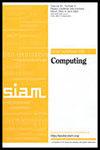On Testability of First-Order Properties in Bounded-Degree Graphs and Connections to Proximity-Oblivious Testing
IF 1.6
3区 计算机科学
Q3 COMPUTER SCIENCE, THEORY & METHODS
引用次数: 0
Abstract
SIAM Journal on Computing, Volume 53, Issue 4, Page 825-883, August 2024.Abstract. We study property testing of properties that are definable in first-order logic (FO) in the bounded-degree graph and relational structure models. We show that any FO property that is defined by a formula with quantifier prefix [math] is testable (i.e., testable with constant query complexity), while there exists an FO property that is expressible by a formula with quantifier prefix [math] that is not testable. In the dense graph model, a similar picture has long been known [N. Alon, E. Fischer, M. Krivelevich, and M. Szegedy, Combinatorica, 20 (2000), pp. 451–476] despite the very different nature of the two models. In particular, we obtain our lower bound by an FO formula that defines a class of bounded-degree expanders, based on zig-zag products of graphs. We expect this to be of independent interest. We then use our class of FO definable bounded-degree expanders to answer a long-standing open problem for proximity-oblivious testers (POTs). POTs are a class of particularly simple testing algorithms, where a basic test is performed a number of times that may depend on the proximity parameter, but the basic test itself is independent of the proximity parameter. In their seminal work, Goldreich and Ron [STOC 2009; SIAM J. Comput., 40 (2011), pp. 534–566] show that the graph properties that are constant-query proximity-oblivious testable in the bounded-degree model are precisely the properties that can be expressed as a generalized subgraph freeness (GSF) property that satisfies the non-propagation condition. It is left open whether the non-propagation condition is necessary. Indeed, calling properties expressible as a generalized subgraph freeness property GSF-local properties, they ask whether all GSF-local properties are non-propagating. We give a negative answer by showing that our FO definable property is GSF-local and propagating. Hence, in particular, our property does not admit a POT, despite being GSF-local. For this result we establish a new connection between FO properties and GSF-local properties via neighborhood profiles.
论有界域图中一阶属性的可测试性及与邻近性模糊测试的联系
SIAM 计算期刊》,第 53 卷第 4 期,第 825-883 页,2024 年 8 月。 摘要。我们研究了有界度图模型和关系结构模型中一阶逻辑(FO)可定义属性的属性测试。我们证明,任何由带量词前缀[math]的公式定义的一阶逻辑属性都是可测试的(即以恒定的查询复杂度进行测试),而存在一个由带量词前缀[math]的公式表达的一阶逻辑属性是不可测试的。Alon, E. Fischer, M. Krivelevich, and M. Szegedy, Combinatorica, 20 (2000), pp.特别是,我们通过一个 FO 公式获得了下界,该公式定义了一类基于图的之字形乘积的有界度扩展器。我们希望这一点能引起我们的兴趣。然后,我们将利用我们这一类可定义的有界度扩展器来回答一个长期悬而未决的问题--近似盲测试器(POTs)。POT 是一类特别简单的测试算法,其中基本测试的执行次数可能取决于邻近度参数,但基本测试本身与邻近度参数无关。Goldreich 和 Ron [STOC 2009; SIAM J. Comput., 40 (2011), pp.至于非传播条件是否必要,目前还没有定论。事实上,将可表达为广义子图自由性属性的属性称为 GSF 局部属性,他们会问是否所有 GSF 局部属性都是非传播的。我们给出了否定的答案,证明了我们的 FO 可定义属性是 GSF 局部属性和传播属性。因此,特别是,尽管我们的属性是 GSF-local 属性,但它并不包含 POT。为此,我们通过邻域轮廓在 FO 性质和 GSF-local 性质之间建立了新的联系。
本文章由计算机程序翻译,如有差异,请以英文原文为准。
求助全文
约1分钟内获得全文
求助全文
来源期刊

SIAM Journal on Computing
工程技术-计算机:理论方法
CiteScore
4.60
自引率
0.00%
发文量
68
审稿时长
6-12 weeks
期刊介绍:
The SIAM Journal on Computing aims to provide coverage of the most significant work going on in the mathematical and formal aspects of computer science and nonnumerical computing. Submissions must be clearly written and make a significant technical contribution. Topics include but are not limited to analysis and design of algorithms, algorithmic game theory, data structures, computational complexity, computational algebra, computational aspects of combinatorics and graph theory, computational biology, computational geometry, computational robotics, the mathematical aspects of programming languages, artificial intelligence, computational learning, databases, information retrieval, cryptography, networks, distributed computing, parallel algorithms, and computer architecture.
 求助内容:
求助内容: 应助结果提醒方式:
应助结果提醒方式:


